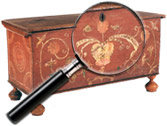|
|
Canning Jars
Canning jars, also called fruit jars, because early versions were primarily used for fruit, or Mason jars, after the best-known manufacturer, are one of those technological advances that have become so ubiquitous we’ve forgotten just how revolutionary the development of food preservation really was. Many of the greatest empires, events and discoveries of the 19th century were largely aided by the development of the canning process. Supplying armies, expeditions and explorations was [...] Click here to continue reading.
The Sarcophagus in Decorative Arts
Derived from the Greek sarx, meaning flesh, and phagein, meaning eat, a sarcophagus is, essentially, a container for a body, much like a coffin or casket. Historically, sarcophagi were typically made of stone (though sometimes of other materials, such as wood or metal), with a relief-carved or pediment top, and designed to be above ground, and have been used by many cultures since ancient times.
An ancient [...] Click here to continue reading.
Newcomb College Art Pottery
Before it was revered for its art, and more specifically for its art pottery, Newcomb College was the country’s first degree-granting college for women within a major university. Its founder, Josephine L. Newcomb, envisioned an environment in which women would learn both practical skills and academic knowledge when she proposed the creation of the college in the memory of her daughter H. Sophie Newcomb, who died at 15. New Orleans’s [...] Click here to continue reading.
Hummel marks Hummel Figurines
History
Berta Hummel (May 21, 1909 to November 6, 1946) was born Massing, Bavaria, and the young girl exhibited artistic talents early, drawing little sketches with images of her friends or things she observed in nature. Her family encouraged her abilities, and by 1927, she enrolled in Munich’s Academy of Fine and Applied Arts. While still a student, Berta became friendly with two Franciscan nuns who were members of [...] Click here to continue reading.
Jacob Medinger Pennsylvania Sgraffito decorated redware plate with deer decoration, p4A item B185545 Jacob Medinger
The Pennsylvania German potter Jacob Medinger was the son of William Medinger, who immigrated in 1854 to Pennsylvania from Wurttemberg, Germany, where he had served his potter’s apprenticeship. The Medingers settled in Neiffer (Limerick Township) in Montgomery County where he set up his own pottery in 1855, an area selected for the local clay deposits that were suitable [...] Click here to continue reading.
Cassolette
“Cassolette,” the diminutive form of the French word “cassole,” means small container. While the word has other meanings, in the world of decorative arts, it refers to a small covered vase meant to hold perfumed substances or incense. A cassolette normally has holes pierced in the shoulders and in the cover to allow the scent to drift out. Frequently, mounted vases that were not originally designed as cassolettes have had a pierced metal [...] Click here to continue reading.
Gemels
The pottery form known as a gemel, also gemel jug or gemel bottle, is one of the rarest forms in American stoneware. The word is derived from the Latin word “geminus,” meaning twin, double, paired, or half-and-half. The plural of this same word, “gemini,” is used to refer to the constellation composed of twin brothers, Castor and Pollux, of Greek mythology. The words “twin” or “double” definitely come to mind when one thinks [...] Click here to continue reading.
Apocryphal – Definition
Apocryphal, the adjective form, means “of doubtful authenticity,” according to Merriam-Webster’s online dictionary. Apocrypha, the noun form, means “writings or statements of dubious authenticity,” again according to Merriam-Webster.
Apocrypha is actually a Greek word that means something closer to “obscure” or “hidden away.” The original meaning of the word, the Apocrypha in the proper noun sense, refers to religious texts outside of the traditional or accepted religious canon. Through connection with [...] Click here to continue reading.
Clarice Cliff (1899-1972)
Colorful & Quirky Ceramics
The Newport Pottery Bizarre Girls created bold Art Deco ware. Clarice Cliff’s hugely popular Art Deco era pottery features simple, streamlined forms decorated in brilliant colors and eye-catching patterns.
Clarice Cliff, one of eight children in a pottery making family grew up in the heart of Staffordshire pottery country in England. By the age of 17 she was working as a decorator at Wilkinson’s Royal Pottery where [...] Click here to continue reading.
Dave Drake, the Slave Potter
The potter known as Dave the Slave was born circa 1800 in an area devoted to pottery making. The Edgefield District of South Carolina had the clay, workforce and demand to make it the area’s pottery capital. Large pottery factories dotted the district, most operating with slave labor. Their products were essential to life on the early to mid-19th century plantation where pottery served as refrigerator, Mason jar and [...] Click here to continue reading.
|
Recent Articles
- Charles Alfred Meurer – American Artist & Tromp L’Oeil Artist
- Sendak, Maurice – American Artist & Writer
- Godie, Lee – American Artist
- Davis, Vestie – American Artist
- Bartlett, Morton – American Artist
- Mackintosh, Dwight – American Artist
- Evans, Minnie Jones – African-American Artist
- Mumma, Ed (Mr. Eddy) – American Artist
- Nice, Don – American Artist
- Savitsky, John (Jack) – American Artist
- Gordon, Harold Theodore (Ted) – American Artist
- Dial, Thornton – African-American Artist
- Doyle Sam – American Artist
- Johnson, Lester Frederick – American Artist
- Finster, Howard – American Artist
|
|
